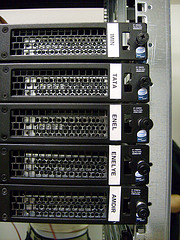
- Select appropriate machine: OfficeClip runs on Windows 7 or higher for client operating system and Windows 2008-R2 or higher for server operating system. The staging machine could be also virtual machine environment with at least 2 GB of memory (4 GB is better for larger databases) and have at least 20GB of disk space (or at least 10GB more than the size of your upload folder).
- Backup information from production: You will need the backup of your production database, upload folder and the configuration files (web.config, dynamic.config and db.config). This can be done individually (as per your organization backup policy) or by running OfficeClip.Tools.OCBackupGUI.exe from the OfficeClip installation directory.
- Install OfficeClip on the staging server: Download the recent version of OfficeClip from our website at /web/download.html and click on setup.exe. This will also install Sql express to the staging server (if you would rather use your own sql server for the staging, then run SetupNoSql.exe). Once the installation is complete, create an account on the system and make sure OfficeClip applications comes up.
- Restore database, files and IIS settings: Do a database restore of the backup you created in step 2 to the same database of the staging server. If you are doing this manually, you can do this using the Sql Management Studio. Next restore the upload folder from production to the same folder in the staging server. Alternatively, run OfficeClip.Tools.OCBackupGUI.exe from the OfficeClip installation directory and restore the database file and the upload folder (do *not* restore the configuration files). If you made any IIS settings changes in the production, you need to do those in the staging server also.
- Change config files and customization: Next copy the dynamic.config file from the production to the staging server. Make sure that some of the values in the dynamic.config file may be different from your production environment (if you have changed it manually in the production), you will need to change it appropriately. If you have done any customization in OfficeClip using the custom folder, then you will need to copy the web.config file from the production environment to the staging server. Also make sure you copy the custom folders (as given by the value of customXml key) to the staging server. Finally check all the folders under App_Themes folder and copy to staging server if they are missing.
- Login and Test: Now login to the staging server with your production login id and password. It should automatically upgrade the OfficeClip database and allow you to login. This is your staging server and you can test it now.
- Update the production server: When you are ready to move the changes to production server, just upgrade the production environment with the same release.
Making Amazon Ec2 instance as a staging server
How to use Amazon ec2 with OfficeClip and then start from Step 4 above.
photo courtesy Flickr Creative Commons Attribution
SK Dutta is a software architect and creator of OfficeClip Suite of products. He loves to design and develop software that makes people do their job better and more fun. He always explores ways to improve productivity for small businesses. He is also an avid reader in many areas, including psychology, productivity, and business.

